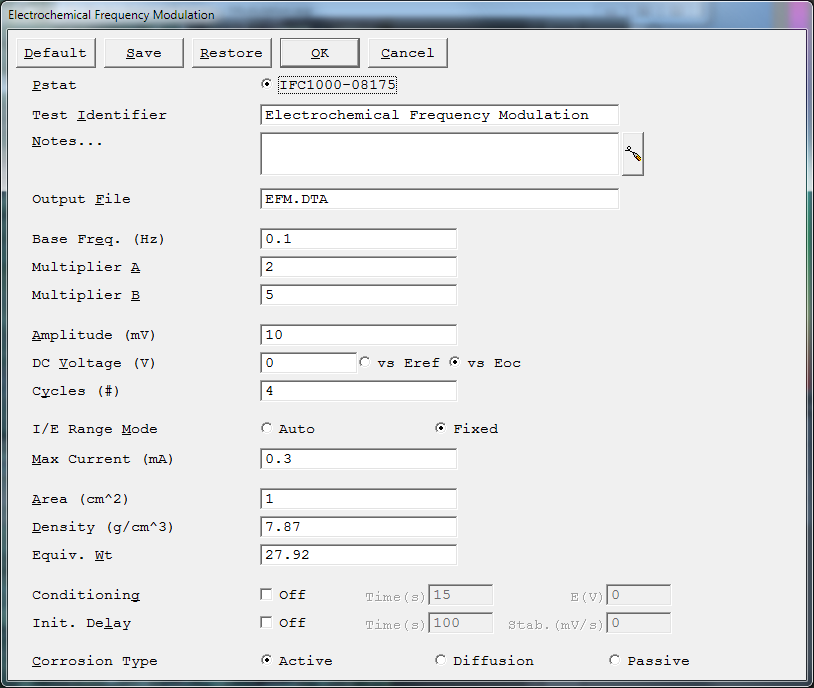EFM Setup Parameters
Here is the setup window for the EFM standard experiment:

Many of the parameters are common to all experiments, and have been covered elsewhere. The parameters specific to the EFM experiment are:
Base Frequency
- The repeat time of the EFM waveform, and helps to define the EFM waveform applied to the cell. The two frequencies simultaneously applied to the cell are
Frequency A = Multiplier A × Base Frequency
and
Frequency B = Multiplier B × Base Frequency
Amplitude
- The amplitude of each of the two sine waves, in mV. The overall EFM waveform amplitude is between 1 and 2 times this number. Choose an Amplitude so that it is small compared to the Tafel constants but large enough to give a reasonable signal. For many systems, 10 to 40 mV is a good starting place.
Multiplier A
- Multiplier A and Multiplier B help to define the EFM waveform applied to the cell. The two frequencies simultaneously applied to the cell are
Frequency A = Multiplier A × Base Frequency
and
Multiplier B
Frequency B = Multiplier B × Base Frequency
- Multiplier B must be at least twice Multiplier A, and the two multipliers may not share any common factors. Suitable multiplier pairs are 2 and 5, or 2 and 7.
DC Voltage
- The voltage applied to the cell. Units are volts and can be versus reference or versus open circuit. For most EFM experiments, the DC Voltage is 0 V vs open circuit.
I/E Range Mode
- The potentiostat’s current-to-voltage converter can operate either in the Autorange mode or in the Fixed Range mode. Because the EFM waveform is a complicated AC waveform, better results are generally obtained in the Fixed Range mode. However, for a survey experiment, or in general use, the Autorange mode can be used successfully. In the Fixed Range mode, the current scale is selected based on the entry for the Max Current. In the Autorange mode, the Max Current is used as an initial guess for the proper scale, but subsequent decisions are based on the value of the most recently measured current.
Number of Cycles
- The Number of Cycles and the Base Frequency determine the duration of an EFM experiment. The greater the number of cycles, the longer the experiment takes, but there is better resolution between peaks in the intermodulation spectrum. Although you may enter any number of cycles, you get better results if the Number of Cycles is a power of two; 2, 4, 8, … 128. The Number of Cycles must be 255 or less.The duration of an EFM experiment is (Number of Cycles + 1) / (Base Frequency). The first repetition of the Base Frequency (the first cycle) is not used for the data analysis.
Max Current
- Controls the current measurement range when the I/E Range Mode is Fixed. When the I/E Range Mode is Autorange, Max Current specifies the maximum expected starting current.Enter a Max Current value that is the largest current that you expect to see during the scans. From this information the software sets the current range used in the experiment. In order to use the most sensitive range that will not overload, the software chooses the current range based on a value that is 89% of the full-scale current range. For example, when using an Interface 1000E, if a Max Current of 89 mA is input, the current range is 100 mA. On the other hand, if you enter a Max Current of 90 mA, the 1000 mA current range is selected.
- NOTE: The Max Current parameter is a current density. The electrode area is not used in the calculation of the current range to use.
- If your current data look very choppy and steppy, the problem could be a poorly-selected current range. If you enter a Max Current value of 10 mA and the maximum current in your sweeps is only 100 mA, you are only using 1/100th of the potentiostat’s A/D converter range. The result is significant quantization error. Rerun the test entering a smaller Max Current in Setup.If your current data show perfectly flat, horizontal regions, the current has most likely overloaded the potentiostat’s current-measurement circuits. Check that the value that you entered for the Max Current parameter is larger that the actual measured cell current. Try rerunning the test with a larger value for the Max Current.
Corrosion Type
- The calculation of corrosion current from EFM data depends upon the mechanism of the corrosion process. The three choices are Active, Diffusion control, and Passive film control. Your choice here only determines the equation for the run-time display. You may change your choice and recalculate corrosion rate in the Echem Analyst™ without having to rerun the experiment.

Comments are closed.